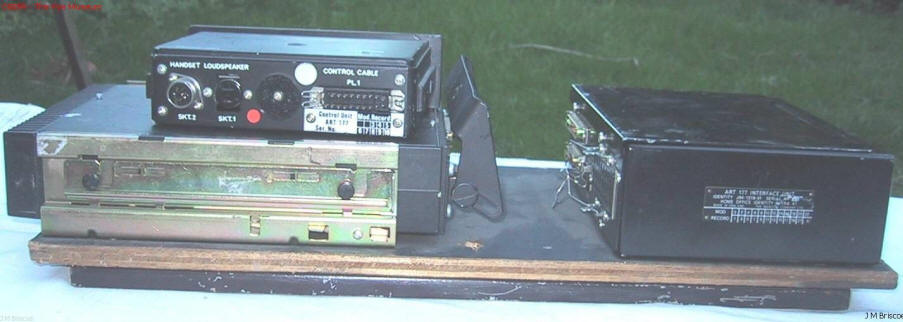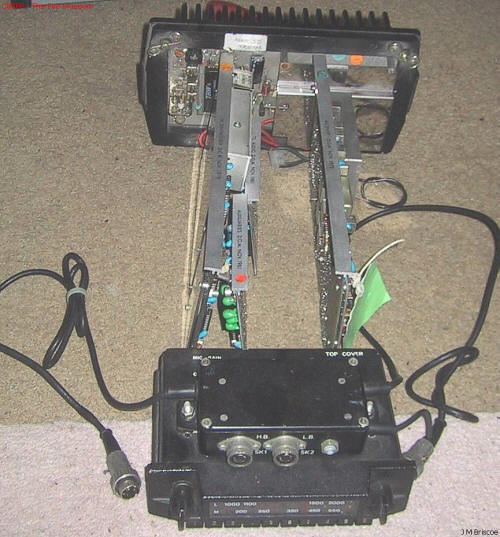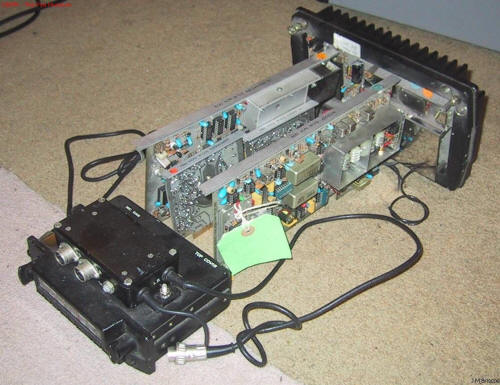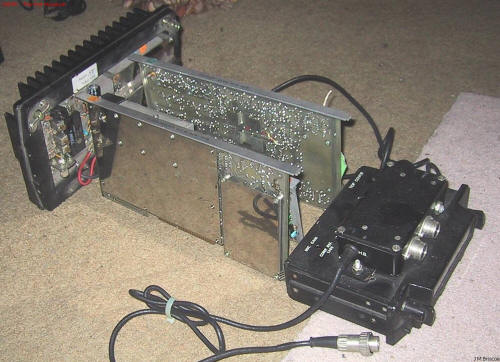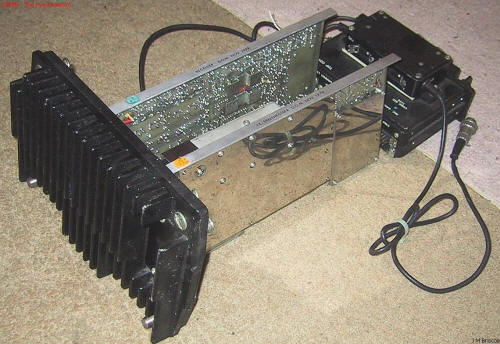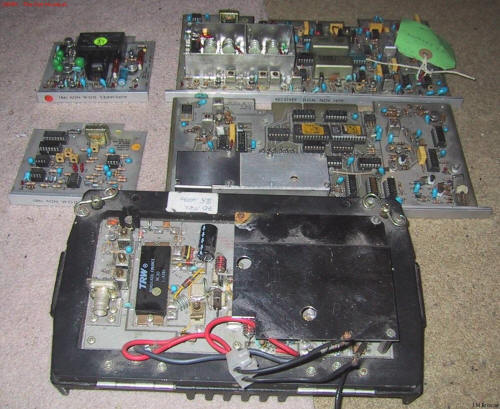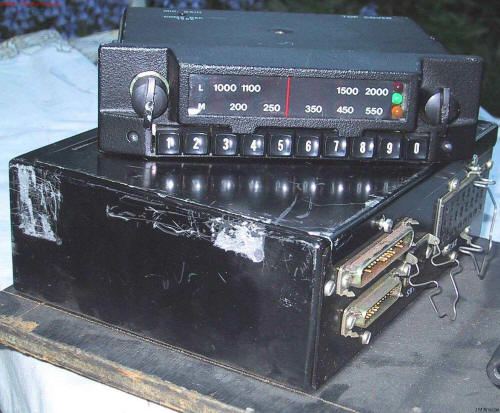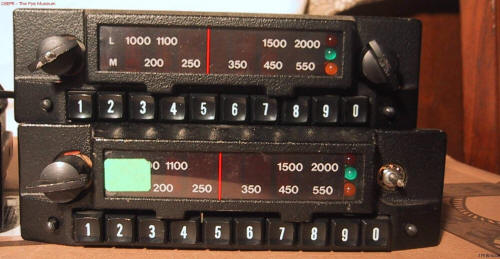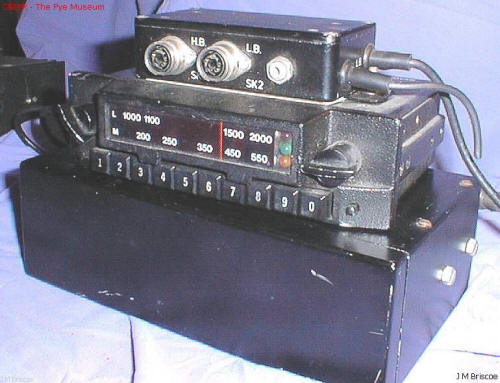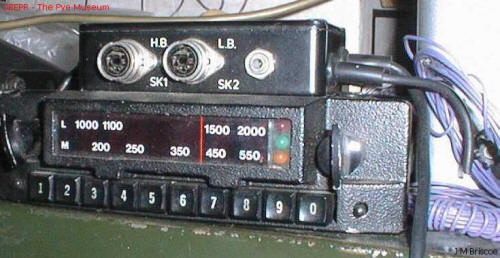ART177.
Circa 1978.
Old P Band 80 – 102 MHz.
A synthesized 500 plus channel covert set for Crime Squad / Special Branch
national use, using
EPROMed channels
Covert 900 channel control box looks like a car radio unit to control an ART177 TX-RX
and RC675 via a ART177 interface unit box.
1 OFF in stock.
Channel selection 3 digit LED readout behind car radio LW-MW dial. Selected by pushing "0" to "9" digit buttons below the dial facia.
Channel 000 to 500 to select P Band
ART177
Channel 700 to 900 to select 143 MHz - 156 MHz band
RC675.
About 1985 onwards. Then all or most ART177 synthesized 500 channel boot mounted sets were scrapped.
As used by Margaret Thatcher in her official cars.
3 OFF. Plus one interface box to connect to RC675 / ART177 / PMR2 etc.
1 OFF ART177 set. No case, incomplete no mother board PCB's. Complete transmitter synthesized board, receiver front end board and complete rear chassis with PA unit.
Notes on ART177
The ART177 was made by a company called Advanced Radio Telephones under a Home Office contract, don't know if they had anything to do with Marconi.
The 900 channel covert head is actually a full channel controller. It has a 3 digit LED display where the long medium/wave band area is. if you typed in three digits on the display it would automatically go to that channel after a short time. It was a bugger to use because if you were mobile and for instance typed in 123 but somehow pressed the 3 twice you had to press the 1 button three times to get it in the right position again. The radio operated on every mainscheme Police VHF channel in the country and was dual AM/FM.
The interface box you describe from the ART177control head to the RC675 was needed during the changeover from Low Band to High Band VHF after the WARC 79 changes, and you needed to be able to operate on both low and high VHF as forces changed at different times, so instead of two control heads the ART177 control head was interfaced through the box to operate the RC675.
If you selected a channel number from 001 to 699 it operated the ART177
If you selected a channel from 700-900 it operated the RC675.
After the changeover of the English forces the Scottish forces changed and the RC675 required a further interface box to give scanning and voting facilities and CTCSS.
With regard to the RC675 MTR110 the control head was designed by one engineer and the radio by another and they did not speak to each other about the wiring of the 37 way plug, as a result the wiring on the control head is the reverse of that on the radio and you need a little ceramic converter to go between the unit and the straight through cable. On the MTR111 I believe this was corrected.
The McMichael RC675's I've seen are blue and they also have a block PA instead of the discrete board used in the Marconi ones.
If you have all the proper interface boxes then the ART177 control head should work with the RC675. After the ART177 main unit was pulled from our vehicles we continued to use the 177 control head. Apparently at one time there were not enough RC675 control heads to go round so the 177 control box was left in many vehicles.
With thanks to DAVE G1JWG for these ART177 notes.
Notes about the ART177 from Graham Cox
In fact A.R.T. was just Dymar, operating under a pseudonym. The set was designed and manufactured entirely by Dymar. Most of the work predated the time I worked in R&D, but I was involved in some of the productionization work on this set. Its designer was Alan Hudson, Dymar's Technical Director, who went on to head up Motorola's cellphone division though I have no idea where he went after that. If the actual sets have any manufacturer's labels on them, they probably say "Advanced Radiotelephones Limited, Grayshott, Hants." In fact this was Alan Hudson's home address.
Close comparison between the ART and other Dymar equipment of the era should reveal very similar construction techniques, materials, components, circuit track layout style and so on. I'm not sure if the ART had its own range of drawing numbers - Dymar's were always of the form Ax-123456-yyyy where x is 0, 1, 2, 3 etc indicating the drawing paper size, and yyyy was the revision number. Circuit boards have the drawing number etched into the track pattern somewhere.
I think I have a technical manual for the ART177 somewhere, including circuit schematics, etc. Would you be interested in a copy? (I can't promise I still have it, it's been many years).
The RC675 aspect came later - I know nothing about that as I left Dymar in '84.
Incidentally Alan Hudson was also responsible for the design decisions (if not the actual circuitry) for the Lynx 2000 range. These represent a very different approach from the previous 830/850 mobiles, which are far better constructed. The Lynx 2000 was built down to a cost, whereas the previous models were built to a specification (and were very costly to make). Not that the 2000s are bad sets, but the unitary rx/tx circuit board and much cheaper chassis are obviously not as high quality as the others. The main problems with the 2000s are a) very early models are not reverse-polarity proof, b) transmitter instability is very easy to induce especially if retuning a set down to a lower band from its normal one, and c) they will rapidly overheat if left on transmit for too long. I did much work on all types of 2000s when I worked at Dymar. I even built a version for CB27/81 that had a built-in scanner and digital channel display (This wasn't an official project, and in my defence I will say I was young - just 18 actually.) I would hazard a guess that is was probably one of the finest CB sets ever built - there aren't many with 7-pole crystal filters and 25W of unboosted power.
An interesting set to look out for is another special design commission called the 1995, which we built for British Gas. This is a bit like a mini-ART, with AM and FM operation, EPROM-programmed channel synthesiser, and a physical design that looks a bit like a big 2000, only with a cast metal chassis instead of a folded/extruded one. The control head either slots directly into the main unit, or can be remotely connected for boot-mounting the main unit. Channel selection is via thumbwheel switches. These sets have fabulous performance and are highly customisable for amateur use, etc. The '1995' refers to the expected retirement date of the sets, which when we designed them was 15 years away. Assuming BG stuck to this I would have though there were quite a few on the second-hand market now. Note that while these were designed and prototyped by Dymar, the actual manufacturing was done by another company (some underhand shenanigans went on there) which was actually one of the reasons that Dymar crumbled into a state where it got bought out and asset-stripped. That and cellphones of course.
The Dymar prototype on your site is unknown to me. It looks like it was probably built in the mid-to-late 70s at the latest, as its construction appears similar to the 830 series. It's possible that it was tendered for the same contract that went to the ART177. This might seem odd as the ART177 was built by Dymar but I seem to recall that the situation was that the ART177 was designed by Alan Hudson as an independent design and then Dymar was brought in to manufacture it - probably some deal was done that also put AH on the board of Dymar as Tech Director as part of the deal... it seems convoluted and may not be accurate, but this sort of thing goes on all the time.
Certainly the original designer of the ART177 was Alan Hudson. What isn't clear to me is whether the older R/T company Hudson Radiotelephones was anything to do with him or whether the name is just a coincidence.
AH submitted his design to the Home Office in response to an HO invitation to tender along with other company's designs, possibly including the Dymar prototype on your site. AH submitted under the company name "Advanced Radiotelephones", but as far as I know, this wasn't a manufacturing company, just a company set up by AH for the sole purpose of submitting the design to the HO. When AH received the HO contract, the actual development, productionisation and manufacturing was all done by Dymar. Now I have no idea what deal was done between Dymar and AH for this - given that the sets were all labelled with "Advanced Radiotelephones, Grayshott, Hants" and that Dymar's name never appeared on them (perhaps for reasons of secrecy or simply legal reasons) - it's likely that unless AH himself contacts you the full story will never be known. The designation ART177 comes from "Advanced Radio Telephone", Mark 1, 1977.
What I do know is that Dymar basically developed and manufactured the set completely as part of its normal processes once the contract was awarded in 1978. That's why I wonder if there are telltale drawing numbers etched on the PCBs which will follow Dymar's format. On the other hand it's possible that a separate sequence of drawing numbers were issued for the ART. (Incidentally Dymar often manufactured equipment for other companies - for example the PCBs in the Quad 44 Hi-Fi amplifier were all made by Dymar!
AH himself was on Dymar's board of directors as Technical Director, and under that role he also led the design of the entire Lynx 2000 series and the 1995 Norgas mobile (which is what I was mostly involved in myself as an R&D engineer). None of these designs had anything to do with Advanced Radiotelephones the company, though shared much technology with the ART177.
Regarding publishing of my letter, or parts of it. I'm not concerned about a knock on the door from MI5, at this stage ;-) And I guess that whatever deals were done between AH and Dymar are ancient history now, so there are probably no legal issues there (which is what I suppose I was most concerned about). So yeah, why not go ahead? If you get any responses that contradict anything though I'd be happy to comment, since naturally a very great deal of time has passed and my memory may be hazy. There are others who are probably much more aware of the nuts and bolts of the company dealings as well as the sets themselves (I personally never worked on the ART, only its spinoffs) who can fill in and/or correct any misinformation. If you get letters from Alan Hudson, Alan Braby, Bob Johnson, Stuart Pile... well, tell them I said Hi and I defer to their much better informed positions within the company!
On another note, I see that while the original Dymar buildings where the manufacturing, testing and the R&D took place are all still standing (occupied by a pharmaceuticals company), the HQ building has sadly been demolished and replaced with a steel and glass office block.
This ART177 was bought at the July 2013 Reading Radio Rally from Bas G8DOR who had it donated to the Thames Valley repeater group stand by the designer(Alan Hudson) of this AM FM P Band Transceiver .
He had decided to clear his loft of collected radios because of old age setting in.
Dave Hicks .
| We have been informed that Alan Hudson died on 24th November 2015 |
..
